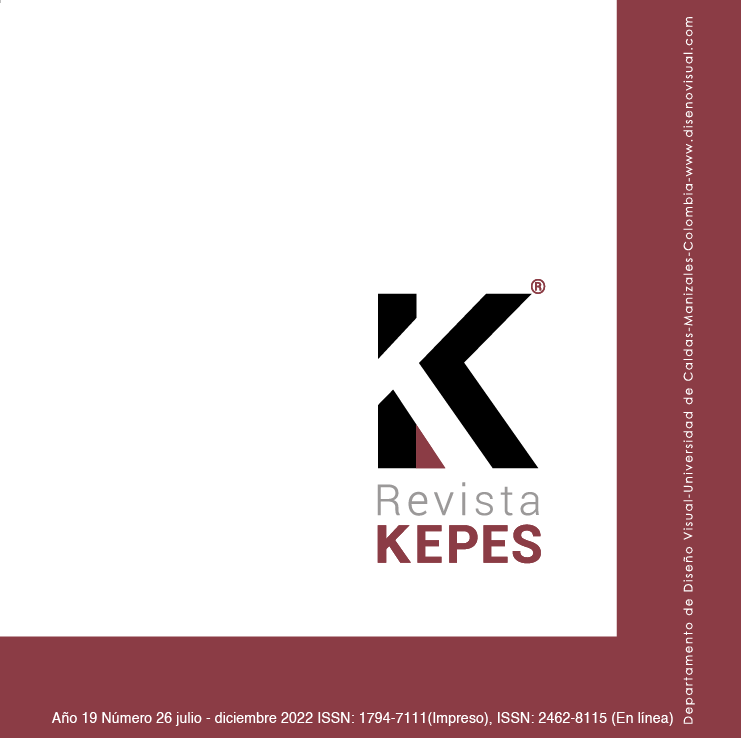Authors
Abstract
This article gives an account of a research whose purpose was to make the Chile Mummy collection visible to scholars and those interested in the area and to collect aspects to be projected from the perspective of Design. The way-of-doing is explored, analyzing the textile conformation of the pieces, establishing relationships to recognize its meaning and identity, and thus make it visible through the dissemination of results. The methodological process considers two stages: the first oriented to the analysis of the objects that make up the collection, and the second, establishes relationships
to outline cultural meaning in the analyzed pieces, based on specialized bibliography on Andean textiles and interviews with experts in the field. The functional textile object called harpoon holder, dating from approximately 1300-1470 AD, during the Late Intermediate Period, is presented as a case study. Its cultural identification is pre-Hispanic, specifically belonging to the Arica Culture. From an analytical perspective and in order to understand
its textile manufacturing and the weaving techniques it uses were studied. In that instance, the object becomes evidence of a formal solution. The study allows concluding that three milestones are recognized in the manifestation of products: existence of a need, projection to satisfy it and elaboration, shaping a response, parallel with the work of the designer. From the reading of the archeological pieces it is concluded that their study contributes to Design. However, it must exclude appropriation, that is the transfer of an iconographic and/or morphological language. This is to ignore its origin and meaning, ignoring its semantic meaning. Preserving and disseminating ancestral technologies contribute to nurturing Design as well as craftsmanship providing, belonging, territoriality and registration for the new generations of professionals who deal with the textile world.
References
Arnold, D. et al. (2017). El rincón de las cabezas: luchas textuales, educación y tierra en los Andes. Instituto de Lengua y Cultura Aymara.
Arnold, D. et al. (2019). Aprendizaje colaborativo en hacer una ontología del dominio del textil andino. Informes de investigación II Nº 10 ILCA. Instituto de Lengua y Cultura Aymara.
Arnold, D. y Espejo, E. (2012). El textil tridimensional: la naturaleza del tejido como objeto y como sujeto. Edición ILCA. Instituto de Lengua y Cultura Aymara. DOI: 10.13140/RG.2.1.1521.3528
Ballester, B. (2017). La delgada línea roja: Sogas de arpón de los últimos cazadores marinos del norte de Chile (1000-1500 dc). Revista Chilena de Antropología, 35, 47-71. DOI: 10.5354/0719-1472.2017.46130
Bustamante, M., Iglesias, A., Günther, P. y Ojeda, B. (2018). Reflexiones para la construcción de una propuesta metodológica dirigida al estudio de piezas textiles arqueológicas desde la perspectiva del diseño. Revista Anales Museo de Historia Natural de Valparaíso, 31.
Carmona, G. (2004). Los Textiles en el contexto multiétnico del período Tardío en Arica. Revista Chungara (Arica), 36(supl.espec.t1).
Córdova-González, J., Chacama, J. y Carrasco, A. (2008). Catálogo Arica, Cultura Milenaria. Centro Cultural Palacio La Moneda. https://issuu.com/marianababarovic/docs/arica_cultura_milenaria
Espoueys, O., Schiappacasse, V., Berenguer, J. y Uribe, M. (2015). En torno al surgimiento de la cultura Arica. https://www.researchgate.net/
Frame, M. (2005). Recuperando el pasado: La conservación de textiles arqueológicos y etnográficos. Conferencia: Senderos hacia el pasado: Estrategias para investigar textiles andinos prehispánicos. 5º NATCC Actas del Congreso de Conservación de Textiles de América del Norte.
Gallardo, F. y Cornejo, L. (1992). “Colores de América”. Museo Chileno de Arte Precolombino. Santiago, Chile.
Gil, C. (2016). La estética textil como intersubjetividad de los pueblos originarios. Revista San Gregorio, 11(1), 58-69.
Gillow, J. y Sentance, B. (2000). Tejidos del Mundo. Guía visual de las técnicas tradicionales. Editorial Nerea S.A.
Günther, P. (2009). Manos de Urdido. Tejidos de Valle Hermoso La Ligua, Región Valparaíso. Universidad de Valparaíso DIPUV Nº 30/2005.
Hidalgo, J. y Focacci, G. (1986). Multietnicidad en Arica, S XVI. Evidencias etnohistóricas y arqueológicas. Revista Chungara, 16-17, 137-147. http://chungara.cl/Vols/1986/Vol1617/Multietnicidad_en_Arica.pdf
Hoces de la Guardia, S. (2011). Legado de artesanos textiles precolombinos en Andinoamérica. El caso Maya. DPB Bailoni. Revista Iconofacto, 7(8).
Hoces de la Guardia, S. y Brugnoli, P. (2006). Manual de técnicas textiles andinas. Terminaciones. Fomento del Libro y la Lectura - 2004 - Chile.
Hoces de la Guardia, S. y Brugnoli, P. (2016). Manual de técnicas textiles andinas. Representación. Editorial Ocholibros.
Horta, H. (2015). El Señorío Arica y los reinos altiplánicos: complementariedad ecológica y multietnicidad durante los siglos pre-conquista en el norte de Chile (1000-1540 d.C.). Universidad de Chile.
López, S. (2006). El poder de torcer, anudar y trenzar a través de los siglos. Textiles y ritual funerario en la Puna Meridional Argentina. Cuadernos del Instituto Nacional de Antropología y Pensamiento Latinoamericano 21.
Malo, P. (2015). Los textiles en el mundo andino. documentacion.cidap.gob.ec
Muñoz, I. y Chacama, J. (1995). Uso del Espacio y Relaciones Interculturales en la Sierra de Arica: el Caso de las Sociedades Prehispánicas del Periodo Intermedio Tardío. II Congreso Chileno de Antropología. Colegio de Antropólogos de Chile A. G., Valdivia.
Murra, J. (1989). Las funciones del tejido andino en diversos contextos sociales y políticos. Arte Mayor de los Andes. Museo Chileno de Arte Precolombino.
Pérez de Micou, C. (2003). Pautas descriptivas para el análisis de cestería arqueología. Actas del Simposio ARQ-2. Tejiendo Sueños en el Cono Sur. Textiles Andinos, Pasado Presente y Futuro. Congreso Internacional de Americanistas, Santiago de Chile 2003.
Sánchez-Parga, J. (1995). Textos textiles en la tradición cultural andina. Instituto Andino de Artes Populares del Convenio Andrés Bello.
Standen, V. (2003). Bienes funerarios del cementerio Chinchorro. Morro 1: descripción, análisis e interpretación. Chungara, Revista de Antropología Chilena, 35(2), 175-207. doi.org/10.4067/S0717-73562003000200002
Ulloa, L. (1983). Documento carta enviada al Museo de Historia Natural de Valparaíso. Libro Registro Museo de Historia Natural de Valparaíso.

 PDF (Español)
PDF (Español)
 FLIP
FLIP






















